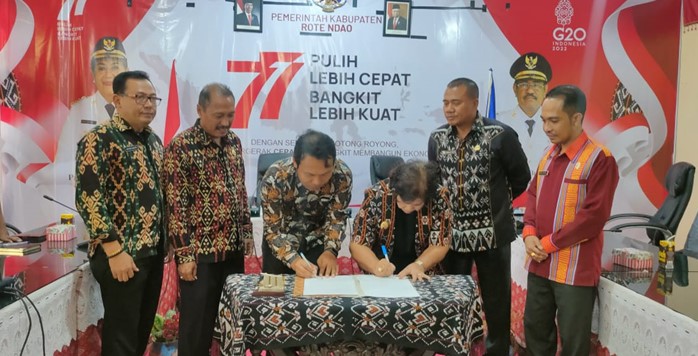Rote Ndao is an island district that is particularly rich in resources. With 27,493 ha of coral reefs, 4,699 ha of seagrass beds and 2,156 ha of mangrove areas, the region provides livelihoods for more than 2,393 fishing households. However, these resources – and the people that rely on them for survival – are vulnerable to climate change impacts and marine pollution, particularly in the form of oil spills.
The district requires comprehensive policies to advance sustainable development. The ATSEA-2 Project took a significant step forward in promoting regional policies related to integrated coastal management (ICM), by handing over an academic paper to the Rote Ndao District Government. Delivered by Dwi Ariyoga on behalf of the project team, this document was received by the Head of Rote Ndao District, Paulina Haning-Bullu, on 2 March 2023.

The academic paper had been developed by a team of scholars from Nusa Lontar University in Rote Ndao, who identified the current issues based on various sources of information, including field consultations and literature review by the ATSEA-2 Project. The aim of the paper is to propose a comprehensive approach for ICM that addresses five crucial domains: protection, restoration and management of habitats; early warning mechanisms to respond to natural disasters and programmes integrated with climate change adaptation; increasing community capacity and resilience to disasters through food security, alternative livelihood management, utilising sustainable resources from the sea and managing clean water; preventing pollution in coastal areas and encouraging waste management efforts; and increasing women’s role in coastal governance, especially in terms of their access to natural resource management, clean water, opportunities to voice their opinions, and inclusion in decision-making processes.
Rote Ndao is home to promising natural resources, as evidenced by its productive capacity: fish production (3,361 tonnes), dried seaweed (15,776 tonnes) and non-fishery products (187.4 tonnes) (BPS, 2017). Since 2019, the tourism sector has also been steadily increasing; with visitor numbers rising from 4,988 in 2019 to 7,500 in 2022, development in this area has helped to boost the local economy. However, the dependence on natural resources leaves many Rote Ndao families exposed to man-made (anthropogenic) and natural disasters.
Recent years have seen a decline in marine ecosystem quality due to unsustainable practices such as destructive fishing methods, sand mining and marine pollution from plastic waste and oil spills. To make matters worse, the local government also has to contend with cross-border fishing challenges that pose risks to safety and violate other countries’ jurisdictional sovereignty. Natural disasters, such as unpredictable storms and weather, make it increasingly difficult for coastal communities to sustain their livelihoods. From 3-5 April 2021, Cyclone Seroja damaged over 1,190 houses and affected 20,000 people in 119 villages. The disaster directly affected livelihoods in the local community, with a disproportionate impact on women.
The academic paper prepared by the team from Nusa Lontar University and the ATSEA-2 Project offers hope that issues related to climate change and disasters can be addressed in a more adaptive manner. Moving forward, the paper will also be shared with the Ministry of Law and Human Rights Regional Office in Kupang, East Nusa Tenggara (NTT), to be integrated into a local regulation that refers to applicable legal rules. It is expected that this policy will support local governments in coordinating more holistic coastal management efforts.
By Dwi Ariyoga Gautama


